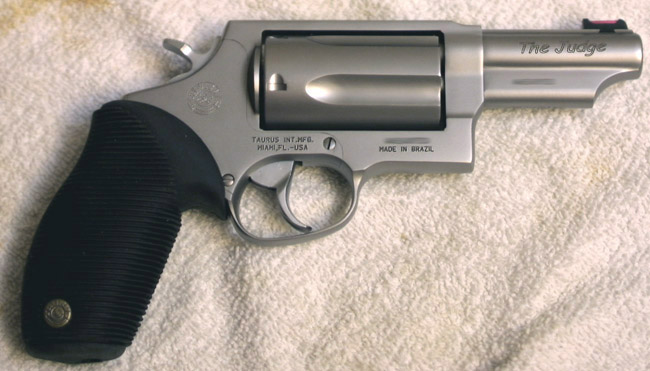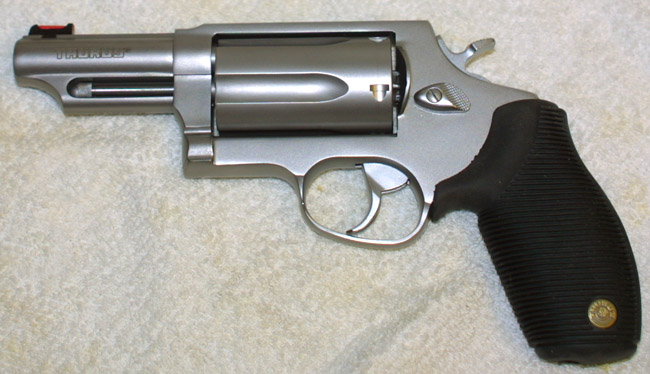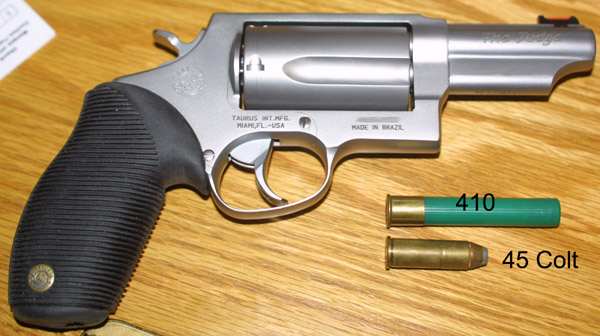 Taurus 410 Revolver
Taurus 410 Revolver
| Dimensions | Barrel Length | Weight | Caliber | Action Type | Magazine Capacity |
| 9" x 5.25" | 3" | 29 oz | 45 L.C. / 410 | Revolver | 5 |
Yes, this is a five shot
revolver, which chambers the 410 shot-shell. It was introduced at
the 2005 Shot Show, and has been recently put on the market. As soon
as I saw one, I knew I had to have it. Officially, this is a model 4510TKR-3SS. For
reasons which can only help in the marketplace, this gun has been
named "The Judge". I recall a sixties muscle car, nicknamed The
Judge (it was a tricked out GTO), and the name didn't hurt
marketing. A judge is a no nonsense, practical type, the ultimate
authority, and one of the good guys. According to Taurus President,
Bob Morrison, a number of judges expressed interest in carrying .410
loads into the courtroom and so the name suggested itself. The gun
is presently being promoted as an anti car-jacking weapon. This is
nominally a 45 Long Colt handgun, with a 2.5" chamber; but it is
probably destined to fire many more 410 shot-shells, than 45 L.C.
cartridges. In recognition of this, the gun has a fiber optic site,
similar to those being put on many shotguns, and also has very light
rifling, that is so shallow, as to appear almost as a set of spiral
scratches on the inside of the barrel. Because of the light rifling,
accuracy with the 45 is not everything that could be hoped for.
Because the rifling, light as it is, happens to be there at all,
pattern consistency with the 410 is not everything that it could be.
The light rifling is one of a number of compromises inherent in the
design of this gun. Like much that is deceptive, or compromised,
this has its origins, along with the fiction that it is designed
primarily to fire the old 45 Colt, in government interference.
knew I had to have it. Officially, this is a model 4510TKR-3SS. For
reasons which can only help in the marketplace, this gun has been
named "The Judge". I recall a sixties muscle car, nicknamed The
Judge (it was a tricked out GTO), and the name didn't hurt
marketing. A judge is a no nonsense, practical type, the ultimate
authority, and one of the good guys. According to Taurus President,
Bob Morrison, a number of judges expressed interest in carrying .410
loads into the courtroom and so the name suggested itself. The gun
is presently being promoted as an anti car-jacking weapon. This is
nominally a 45 Long Colt handgun, with a 2.5" chamber; but it is
probably destined to fire many more 410 shot-shells, than 45 L.C.
cartridges. In recognition of this, the gun has a fiber optic site,
similar to those being put on many shotguns, and also has very light
rifling, that is so shallow, as to appear almost as a set of spiral
scratches on the inside of the barrel. Because of the light rifling,
accuracy with the 45 is not everything that could be hoped for.
Because the rifling, light as it is, happens to be there at all,
pattern consistency with the 410 is not everything that it could be.
The light rifling is one of a number of compromises inherent in the
design of this gun. Like much that is deceptive, or compromised,
this has its origins, along with the fiction that it is designed
primarily to fire the old 45 Colt, in government interference.
In 1934, passage was forced of the NFA (National Firearms Act). This was the first real large scale government legislation regarding firearms. This law was only passed, by fdr browbeating Congress, and threatening to greatly enlarge the Supreme Court (which had indicated that the NFA was obviously unconstitutional, and that they would declare it as such, if passed)***. Through threat, charm, and shameless manipulation of public opinion, fdr managed to get his law passed. One of the provisions of the law, was that possession of the so called "sawed off" shotgun was to be highly restricted, tracked by the government, and taxed. For the purposes of the bill, a shotgun was defined as a smooth bore arm - that is to say, the barrel was to be unrifled. A minimum barrel length of 18" was set, with a minimum overall length of 26". There was also a provision in the NFA, for the restriction of any weapon with a Bore diameter of over half an inch. An exception was made for shotguns.
The Judge, as well as the few other pistols of this type, have taken
advantage of the fact that the base measurements of the 45 Colt, and
the 410 shot-shell are identical . All are all chambered for the 45
Colt cartridge, but have had their chambers lengthened to permit
chambering of 410 shot-shells. This makes them, in theory, regular
handguns, firing regular handgun cartridges. This, along with their
rifled barrels, makes them perfectly legal, at least according to
the letter of the law, in the NFA. Certain states have banned these
guns, and others are considering doing so. In addition, the
democrats have indicated that they will be targeting these types of
guns for special attention, in the next Congress; but for now, let's
consider more cheerful subjects.
The rifling on this gun, as was mentioned, is rather light. A look up the barrel shows that the grooves are neither deep, nor particularly sharp. Taurus has stated that the rifling is a compromise, designed to get reasonable performance out of cartridges, or shot-shells. the original solution to this problem, as conceived by Thompson, was a removable clover-leaf choke, with straightened the shot charge out, and then regulated it's pattern. Perhaps Taurus will try this approach in a future model. It is rumored that a model of The Judge, whcih chambers a 3" shell is in the works.
The Judge is a well made, nicely finished revolver, which is made a bit funny looking, by its unusually long cylinder. This is a sort of a Salvador Dali, or funhouse mirror revolver. The sights are great, consisting of your basic rear notch, and a front post with a plastic fiber insert. The soft rubber grips have a series of ribs which both soften and improve the shooters hold on the gun. The trigger is smooth and wide, while the hammer spur is square and checkered. The cylinder release looks and functions in an identical manner to that of the S&W. All in all, the gun makes a great first impression.
The gun is burdened with what I call, the Taurus "cap gun" trigger, which I have come to dislike. The single action trigger on this gun is great, crisp, and clean; but in double action mode, the trigger leaves a bit to be desired. According to my trigger gauge, the double action pull is 11 pounds, 12 ounces; while the single action pull is five pounds, four ounces. This seems to be normal for the Taurus small framed guns, upon which this model is based. I have noticed no such trigger issues on my Raging Bull; but have similar complaints about the triggers on my Model 941, and my model 17. Still, I am hoping these will ease up after break in. This is a new gun, after all. This is generally attributed to some early problems, with Taurus revolvers misfiring. Some of the early guns left light strikes on primers, which caused misfires. Ever since that time, Taurus has used some pretty heavy springs on these guns, which results in some pretty heavy trigger pulls.
The primary market for
this gun, is for home defense So it might be wise to look and see
just how good a home defense gun, The Judge would be. Any firearm's
power is dependent upon the ammunition that it shoots. In the case of The Judge, there
are three basic options. The first option is the 45 Long Colt, of
cowboy and old west fame. This is an option that will probably not
get too much consideration, from most owners of this gun, because
there are better pistol choices, for those who wish to use this
caliber. Still, the old 45 is a proven fight ender, and man stopper,
and will absolutely do the job. The second choice is the use of a
410 slug. The most common weights of slugs for the 410 are 87 grain
(1/5 ounce), and 109 grain (1/4 ounce). These give 640 FP, and 750
FP of energy respectively. This is pretty impressive for a handgun;
but is not outside of what a standard magnum can do, and will
probably not be used by too many Judge owners. Like the 45 Colt,
these loads would be effective; but they are nothing that can not be
had in a more conventional package. The last option, and the one
which will most likely be settled upon by most owners of this gun,
is that of the basic shot-shell.
upon the ammunition that it shoots. In the case of The Judge, there
are three basic options. The first option is the 45 Long Colt, of
cowboy and old west fame. This is an option that will probably not
get too much consideration, from most owners of this gun, because
there are better pistol choices, for those who wish to use this
caliber. Still, the old 45 is a proven fight ender, and man stopper,
and will absolutely do the job. The second choice is the use of a
410 slug. The most common weights of slugs for the 410 are 87 grain
(1/5 ounce), and 109 grain (1/4 ounce). These give 640 FP, and 750
FP of energy respectively. This is pretty impressive for a handgun;
but is not outside of what a standard magnum can do, and will
probably not be used by too many Judge owners. Like the 45 Colt,
these loads would be effective; but they are nothing that can not be
had in a more conventional package. The last option, and the one
which will most likely be settled upon by most owners of this gun,
is that of the basic shot-shell.
The shot-shell user has a number of choices available. The most obvious is the use of buckshot, though it's use is a bit questionable in the 410. A 410, 000 buckshot load contains three pellets, of around 36 caliber each. Each pellet weighs 71 grains, for a combined weight of 210 grains, partway between the weight of the average 44 Magnum, and the average 41 Magnum slugs. These pellets leave the muzzle at something like 1200 fps. At bedroom distances, the "pattern' will probably not spread very much, so that the target will, in essence, be shot three times, every time the trigger is pulled. Because of their weight, and velocity, each pellet is essentially a standard handgun bullet. The 00 buck load will contain five pellets, of approximately 33 caliber. Each will weigh 54 grains. These leave the muzzle at over 1200 fps, making each the equivalent of a 22 magnum, or perhaps a bit better. The buckshot pellets are fairly large and heavy, and are more like bullets, than traditional shot charges. They tend to hold their energy fairly well, out to perhaps thirty or forty yards. Then there is bird shot.
Bird shot comes in a variety of numbered sizes, and exact dimensions and weights, can be found on my shotgun page. The 2.5 inch shell, which the Taurus holds, contains a half ounce of shot. At ten yards, individual pellets of number 4 bird shot will still be capable of penetrating almost three and a half inches of flesh. The rule of thumb for pellet spread from a shotgun is one inch per yard. Out of the short barrel on the Taurus, particularly with the light rifling, spread may be a bit more. Even so, there will be around 90 pellets, penetrating nearly three and a half inches, and all hitting within about a one foot circle. There is no magnum handgun that can do anything like this. The smaller birdshot, like the number 9 will only penetrate an inch and a half; but there will be something like 200 of them, spraying out of the muzzle of The Judge. At the very least, such a noxious spray will "hurt like hell", at close range, and should certainly take the fight out of even the most aggressive attacker.
The problem with The Judge, as with any shotgun, is that its effectiveness quickly drops off with range. This is particularly true of the smaller pellets. A load of birdshot, at 50 yards, is an annoyance, though buckshot can be lethal out to 100 yards or more; but this too, can be an advantage in a home defense gun. Most Americans no longer live on the family farm, or out in the country. We live in cities, and suburbs. An increasingly large number of us live in apartments, and condos. What this can mean, is that if a householder discharges a firearm, there is a pretty good chance, that the projectile will end up exiting the premises, and entering another household. The more powerful the firearm, the greater the chance of this happening. The average handgun is easily capable of penetrating the walls of the average house, and entering the house of a neighbor, or the apartment next door. The average 410 shotgun, particularly if bird shot is used, is not going to endanger your neighbors, if you miss.
What most owners of this gun
will probably do, is load up the first chamber or two with
shot-shells, and then fill the rest with 45 Colt rounds. I am
presently undecided on how I will use this gun. Right now my home
defense gun depends upon my mood (it's nice to have choices); but
tends to be a stainless revolver, or else the Para-Ordnance.
As far as carrying the Judge, choices are limited, and present a few challenges. The frame of the Judge is generally dimensioned about the same as a K frame Smith; but it is stretched out. The cylinder and the section ahead of the trigger guard have about an inch added to their length. Holster makers are now starting to come out with a variety of way s to carry the Judge; but for a while there were few options. I have a Triple K holster on order, as of this writing. For now I use a Galco which was originally bought for my Glock 17. This works because the extra cylinder length makes the revolver body about the same length as that of a semi auto. I do not necessarily recommend this, as such a design does not properly cover the trigger area; but for now it is better than nothing.
Cartridges can be carried on a shell belt designed for 44/45 rounds. For those wanting speed loaders, there is another set of challenges. Speedloaders designed for the Charter arms 44 Bulldog will work; but only for 45 Colt cartridges. The only speedloaders of which I am aware, that will handle the 410 shot shells are made by 5star ( http://www.5starfirearms.com/index.html ). These are custom made of aluminum, and are quite nice looking, strong, and light. They will not fit into standard holders; but a small accessory pouch will hold them quite nicely.